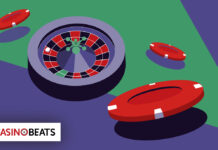Learn the basics of Blackjack, including card values, rules, and how to make decisions to get the house edge under 1%.
Find out about different Blackjack variations like European Blackjack and Spanish 21, and how to play online and in land-based casinos.
Master the essential Blackjack strategies of when to hit, stand, double down, and split to win at the tables.
What Is Blackjack?
Blackjack, also known as 21, is a game where you play against the dealer, not each other. It’s one of the most popular casino table games in the world because of its simple rules and low house edge when played correctly.
The objective of Blackjack is simple: beat the dealer’s hand without going over 21. You win by having a higher total than the dealer (without going over 21) or by the dealer busting. If your first two cards are 21 (an Ace and a 10 value card), you have a “blackjack,” which pays 3:2.
The game is an excellent balance of luck and strategy, so it’s suitable for casual players and serious gamblers.
How to Play Blackjack Online
Playing Blackjack online is convenient and often has better odds than physical casinos. Here’s how to get started:
- Choose a reputable online casino. Select a licensed online casino with positive reviews and a proven track record of fair play.
- Create an account and deposit. Sign up with your details and make a secure deposit. Many online casinos offer welcome bonuses that can be used on Blackjack games.
- Pick your Blackjack game. Most online casinos offer multiple Blackjack games. Choose one that suits your skill level and taste.
- Set your bet. Consider your bankroll management when determining your bet size. A common rule of thumb is to bet no more than 5% of your total bankroll on a hand.
- Play according to basic strategy. Use a basic strategy chart to make the right decisions. Many online casinos allow you to reference strategy charts while playing, not physical casinos.
- Use free play mode. Practice in free play mode before playing for real money. This way, you can become familiar with the interface and test strategies without risk.
- Track your results. Keep a record of your wins and losses to monitor your progress and adjust your strategy as needed.
How to Play Blackjack in a Land-Based Casino
Playing Blackjack in a casino adds a social element and a whole new vibe to the game. Here’s how to do it:
- Watch before you play. Sit and watch a few hands at different tables to get a feel for the pace and minimum bet. Look for tables with 3:2 blackjack payouts.
- Buy chips from the dealer. Put your cash on the table (not in the dealer’s hand), and the dealer will exchange it for chips. Never hand some money to the dealer.
- Wait for the current hand to finish before you sit. It’s good etiquette to wait until the dealer has completed the current hand before taking a seat.
- Put your bet in the betting circle. Put your chips in the designated betting area in front of you before the dealer says “no more bets”.
- Use hand signals to the dealer. To hit, tap the table with your finger. To stand, wave your hand horizontally over your cards. To split or double down, put more chips next to your original bet.
- Never touch the cards in shoe games. In games dealt from a shoe (multiple decks), the cards are dealt face up and should not be touched. In hand-dealt games, you’ll get cards face down and can hold them with one hand.
- Tip the dealer occasionally. Not required, but tipping the dealer (especially during a winning streak) is appreciated and helps create a more positive atmosphere.
- Be aware of other players. While their decisions don’t affect you mathematically, being respectful is appreciated and helps maintain a pleasant game environment.
Blackjack Card Values
Knowing what the cards represent is integral to playing Blackjack. In Blackjack, it only matters what the values are, not the suits, as they do in certain other card games.
| Card | Value |
|---|---|
| 2-10 | Face value (2=2, 3=3, etc.) |
| Jack, Queen, King | 10 |
| Ace | 1 or 11 (whichever benefits the player) |
💡The flexibility of the Ace is what makes Blackjack interesting. A hand with an Ace is called a soft hand because it cannot bust on its next hit (the Ace can change from 11 to 1). If you have an Ace and a 6, for instance, you can add those cards as either 7 or 17, which makes it easier to determine whether you should hit or stand.
Types of Blackjack
Blackjack has numerous variations, each with its own unique rules and strategies. Understanding the differences is crucial for adjusting your play.
Standard Blackjack
Basic Blackjack, also known as American Blackjack, is the most common in US casinos. In this version, the dealer gets two cards at the beginning of the round: one face up and one face down (the “hole card”).
Players make decisions based on their cards and the dealer’s upcard. If the dealer’s upcard is an Ace, players can take “insurance”, a side bet that pays 2:1 if the dealer has a blackjack. Basic Blackjack uses 6-8 decks and allows doubling on any two cards and splitting pairs, with some restrictions on re-splitting.
Video Blackjack
Video Blackjack is the electronic version of the classic card game, where players can enjoy Blackjack without a live dealer. These machines are similar to slot machines, but with Blackjack rules.
The main difference in Video Blackjack is that most machines pay even money (1:1) for a natural blackjack instead of 3:2, as is usually done, really increasing the house edge. Video Blackjack utilizes a random number generator to determine card outcomes. It typically offers minimum bets that are significantly lower than those of the table games, making it an ideal choice for beginners or players with limited bankrolls.
European Blackjack
There are several significant differences between European Blackjack and American Blackjack. The greatest distinction to note is that the dealer is initially dealt only one card at the beginning, and the second card is dealt once all participants have performed their actions.
This rule variation eliminates the dealer’s option to check for blackjack immediately, which slightly increases the house edge. European Blackjack generally uses fewer decks (usually 2), does not permit surrender, and is more restrictive regarding doubling down (usually only hard 9-11) and splitting. These differences necessitate adjustments in basic strategy for American Blackjack.
Spanish 21
Spanish 21 is a fun variant of Blackjack played with Spanish decks, which are 52-card decks with all 10s removed. This provides a 48-card deck, altering the odds and gameplay.
To compensate for the 10s being removed (which increases the house edge), Spanish 21 has player-friendly rules including late surrender, double after split, re-split aces, and bonus payouts for specific Blackjack hand rankings. Player blackjacks always win, even if the dealer has a blackjack. Spanish 21 also has bonus payouts for 21s with five or more cards, making it a wild ride compared to regular Blackjack.
Blackjack Side Bets: The Potential Big Earners
Blackjack side bets provide additional entertainment and usually, but not always, have a larger house advantage than the base game. Here are a few typical side bets:
Insurance
Insurance is offered when the dealer has an ace showing. This side bet pays 2:1 if the dealer has a natural blackjack, but it has an approximately 7% house edge. Most strategists do not recommend insurance unless in particular card-counting scenarios.
Perfect pairs
This side bet pays off if your first two cards are a pair. The payouts vary according to the type of pair: mixed (same value but different colors), colored (same value and color), and perfect pairs (identical cards). The house edge ranges from 4% to 6%, depending on the paytable.
21+3
With the 21+3 side bet, your two cards and the dealer’s upcard are used to make a three-card poker hand. There are also different pay amounts for a flush, a straight, three of a kind, and a straight flush. The house edge ranges from 3% to 8%, depending on the exact paytable.
Lucky ladies
This side bet wins if your first two cards total 20, with larger payouts for pairs of 20s. The top payout is for getting two Queen of Hearts when the dealer has a blackjack. The house takes about 17% on average.
Blackjack Variations
In addition to the primary forms of Blackjack, there are still several variants whose rules differ slightly, impacting strategy and the house edge, even when considering Blackjack online vs. land-based casino variations:
Single-Deck Blackjack has the lowest house advantage (approximately 15% if you play perfectly) since it’s easier to count cards, but watch out for tables that pay 6:5 for blackjack instead of 3:2, which eliminates this advantage.
Multi-Deck Blackjack (4-8 decks) increases the house edge by a small amount and also makes card counting more difficult. To combat advantage players, most casinos employ shoe dealing and use multiple decks of cards.
In Double Exposure, the dealer’s cards are both dealt face-up, which may seem like a benefit to the player, but it is offset by the fact that the dealer wins all ties and that blackjacks pay even money rather than 3 to 2.
Progressive Blackjack includes a side bet that contributes to a progressive jackpot. The side bet typically has a house edge of 10% or more, though the jackpot can be huge.
In Blackjack Switch, players can exchange the top cards of two different hands. In compensation for this, natural blackjacks pay even money instead of the 3:2 payout.
Blackjack Strategies: The Basics
Blackjack is among the rare casino games in which strategy can make a real difference. When playing Blackjack, the most important element of your strategy is that you ultimately make the mathematically correct move given your cards and the dealer’s upcard.
The basic strategy is to memorize the correct play for every possible hand combination. This brings the house edge down to less than 1% in most games.
💡 Hit or Stand: Generally, stand on hard 17 or higher; hit on eight or lower; and make strategic decisions on hands 9-16 based on the dealer’s upcard.
💡 Double Down: Usually double on 11, on 10 (except against the dealer’s 10 or Ace), and on nine against the dealer’s 3-6.
💡 Splitting Pairs: Always split Aces and 8s; never split 10s or 5s; split 2s and 3s against the dealer’s 4-7; split 6s against the dealer’s 2-6; split 7s against the dealer’s 2-7; split 9s against the dealer’s 2-6 and 8-9.
More sophisticated techniques, like card counting, give players a slight statistical advantage by keeping track of the proportion of high to low cards left in the deck, but casinos frown on card counting.
Our Top Blackjack Tips
Follow these tips from a pro and you’ll enjoy Blackjack more; here’s how:
- ✅ Learn basic strategy perfectly: This one step reduces the house edge from 2% to under 1% – This is the highest ROI of your time.
- ✅ Check the rules before you play: Different rule variations can significantly impact the house edge. Look for 3:2 blackjack payouts and liberal doubling and splitting rules.
- ✅ Don’t take insurance: Unless you’re a card counter, insurance is a bad bet with a 7% house edge.
- ✅Set win and loss limits: Decide in advance how much you want to win or lose in a session and stick to those limits.
- ✅ Start at lower stakes tables: Begin at tables with lower minimum bets until you get the hang of the game and basic blackjack strategy.
- ✅ Ignore other players’ advice: Some players will give you strategy advice that contradicts mathematically correct play. Trust the basic strategy.
- ✅ Manage your bankroll: Never bet more than 5% of your total bankroll on a single hand, allowing you to weather variance.
- ✅ Play at less crowded tables: You’ll get more hands per hour, and if you’re playing with a perfect strategy, this minimizes your exposure to the house edge over time.
- ✅How old do you have to be to play Blackjack? Ensure that you check the casino you’re playing at and verify the legal age limit according to your jurisdiction.
Conclusion
Blackjack is one of the most strategic and player-friendly games in the casino. By learning basic strategy, understanding the different game types, and managing your bankroll through responsible gambling, you can have hours of fun with one of the lowest house edges in the casino.
Remember, strategy can reduce the house edge, but Blackjack is a game of chance, and the casino has an advantage in the long run. Approach it as entertainment first and winning as a bonus, not an expectation.
Suppose you’re playing online or at a physical casino. In that case, the principles are the same: make mathematically correct decisions, play within your means, and enjoy the mix of luck and skill that makes Blackjack a classic casino game.
FAQs
Blackjack is played against the dealer. Get a hand value closer to 21 than the dealer without going over. Two cards are dealt to players, and they can “hit” for more cards or “stand” with their current total. The dealer must hit until 17 or higher. Natural blackjacks (an Ace with a 10-value card) pay 3:2.
While both are used interchangeably, there’s a technical difference. “Blackjack” means an Ace and a 10-value card as your first two cards (a “natural”), which pays 3:2. “21” is any hand that totals 21 points, whether two cards or more, and pays 1:1 if you win.
Learn basic strategy, which tells you the mathematically correct play for every hand. Start with small bets as you practice. Look for tables with player-friendly rules, such as 3:2 payouts for blackjack. Set strict loss limits and stick to them. Avoid side bets that have a much higher house edge than the main game.
To maximize your chances of winning, use a perfect basic strategy for every decision, play at tables with favorable rules (3:2 blackjack payouts, dealer stands on soft 17), avoid insurance bets, and practice good bankroll management. While these won’t guarantee wins, they will minimize the house edge to less than 1%.
Blackjack is easy to learn but hard to master. The basic rules are simple: try to get closer to 21 than the dealer without going over 21. But playing optimally requires memorizing basic strategies for many card combinations. The simplicity of the rules combined with strategic depth makes Blackjack fun for both beginners and experts.
Follow basic strategy charts, which tell you the mathematically correct play for every possible hand. Generally, stand on a hard 17 or higher, always hit a hard eight or less, and for hands 9-16, your decision depends on the dealer’s upcard. For soft hands (with Aces), the strategy is different; you’ll often hit soft 17 or lower.
Learn basic strategy, which tells you the correct play for every situation. Start with more straightforward rules: always split Aces and 8s, never split 10s or 5s, double down on 11, and stand on 17 or higher. Play at tables with lower minimums while learning. Use strategy cards (allowed in most casinos) until you memorize the correct plays.
Doubling down is when you double your initial bet, after looking at your first two cards, in exchange for agreeing to stand once you are dealt one more card. It is best used when you have a hand that is likely to win with one more card, such as a hard 10 or 11, or certain soft hands, depending on the dealer’s upcard.








